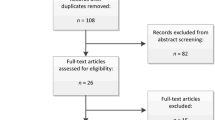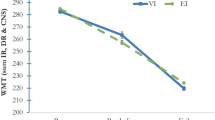Abstract
Performance validity tests (PVTs) effectively detect suboptimal test performance, but cutoff scores for a given test may differ between populations. This research examines how optimal PVT cutoffs differ in a collegiate research population when mental health and clinical conditions are considered. Healthy controls (n = 328) and non-referred students with self-reported clinical conditions (n = 42) were assigned to perform their best while others simulated ADHD symptoms (n = 123). PVT indices were derived from a stand-alone measure (Victoria Symptom Validity Test) and embedded measures (California Verbal Learning Test – Second Edition; Wechsler Adult Intelligence Scale – Fourth Edition, Digit Span). PVT cutoffs with the highest sensitivity, while maintaining adequate specificity, were identified when the control groups were considered together, and when students with reported clinical conditions were considered separately. Mean differences in PVT performances were found between the simulation group and control groups, but not between clinical and nonclinical controls. The optimized cutoffs differed for five of eight PVT indices when all controls were considered together versus the clinical control group, only. When discordance was observed, cutoffs tended to be lower (less stringent) for the non-referred clinical control group. Together, these optimized cutoffs tended to be more stringent than previously established cutoffs. This study suggests that PVT cutoffs may be responsibly altered in a research context in the presence of a clinical condition. Future research should investigate if PVT classification accuracies can be improved in clinical and forensic samples while considering clinical conditions.
Similar content being viewed by others
Notes
Neither demographic comparisons nor between-group comparisons of mean PVT performance meaningfully changed when the HSG and CSG were combined for analyses.
References
American Psychiatric Association. (2013). Diagnostic and statistical manual of mental disorders, fifth edition (DSM-5). Arlington, VA: American Psychiatric Association.
An, K. Y., Kaploun, K., Erdodi, L. A., & Abeare, C. A. (2017). Performance validity in undergraduate research participants: A comparison of failure rates across tests and cutoffs. The Clinical Neuropsychologist, 31(1), 193–206.
An, K. Y., Zakzanis, K. K., & Joordens, S. (2012). Conducting research with non-clinical healthy undergraduates: Does effort play a role in neuropsychological test performance? Archives of Clinical Neuropsychology, 27(8), 849–857.
Axelrod, B. N., Fichtenberg, N. L., Millis, S. R., & Wertheimer, J. C. (2006). Detecting incomplete effort with digit span from the Wechsler adult intelligence scale—Third edition. The Clinical Neuropsychologist, 20(3), 513–523. https://doi.org/10.1080/13854040590967117.
Blanco, C., Okuda, M., Wright, C., Hasin, D. S., Grant, B. F., Liu, S. M., & Olfson, M. (2008). Mental health of college students and their non–college-attending peers: Results from the national epidemiologic study on alcohol and related conditions. Archives of General Psychiatry, 65(12), 1429–1437.
Brooks, B. L., & Ploetz, D. M. (2015). Embedded performance validity on the CVLT-C for youth with neurological disorders. Archives of Clinical Neuropsychology, 30(3), 200–206.
Clark, A. L., Amick, M. M., Fortier, C., Milberg, W. P., & McGlinchey, R. E. (2014). Poor performance validity predicts clinical characteristics and cognitive test performance of OEF/OIF/OND veterans in a research setting. The Clinical Neuropsychologist, 28(5), 802–825.
Considine, C. M., Weisenbach, S. L., Walker, S. J., McFadden, E. M., Franti, L. M., Bieliauskas, L. A., et al. (2011). Auditory memory decrements, without dissimulation, among patients with major depressive disorder. Archives of Clinical Neuropsychology, 26(5), 445–453.
Constantinou, M., Bauer, L., Ashendorf, L., Fisher, J. M., & McCaffrey, R. J. (2005). Is poor performance on recognition memory effort measures indicative of generalized poor performance on neuropsychological tests? Archives of Clinical Neuropsychology, 20(2), 191–198. https://doi.org/10.1016/j.acn.2004.06.002.
Curtis, K. L., Greve, K. W., Bianchini, K. J., & Brennan, A. (2006). California verbal learning test: Indicators of malingered neurocognitive dysfunction. Assessment, 13(1), 46–61. https://doi.org/10.1177/1073191105285210.
Delis, D. C., Kramer, J. H., Kaplan, E., & Ober, B. A. (2000). CVLT-II: California verbal learning test: Adult version. New York, NY: Psychological Corporation.
DeRight, J., & Jorgensen, R. S. (2015). I just want my research credit: Frequency of suboptimal effort in a non-clinical healthy undergraduate sample. The Clinical Neuropsychologist, 29(1), 101–117. https://doi.org/10.1080/13854046.2014.989267.
Erdődi, L. A., Seke, K. R., Shahein, A., Tyson, B. T., Sagar, S., & Roth, R. M. (2017). Low scores on the grooved pegboard test are associated with invalid responding and psychiatric symptoms. Psychology & Neuroscience, 10(3), 325.
Frazier, T. W., Frazier, A. R., Busch, R. M., Kerwood, M. A., & Demaree, H. A. (2008). Detection of simulated ADHD and reading disorder using symptom validity measures. Archives of Clinical Neuropsychology, 23(5), 501–509.
Greiffenstein, M. F., Baker, W. J., & Gola, T. (1994). Validation of malingered amnesia measures with a large clinical sample. Psychological Assessment, 6(3), 218–224. https://doi.org/10.1037/1040-3590.6.3.218.
Grote, C. L., Kooker, E. K., Garron, D. C., Nyenhuis, D. L., Smith, C. A., & Mattingly, M. L. (2000). Performance of compensation seeking and non-compensation seeking samples on the Victoria symptom validity test: Cross-validation and extension of a standardization study. Journal of Clinical and Experimental Neuropsychology, 22(6), 709–719. https://doi.org/10.1076/jcen.22.6.709.958.
Jones, A. (2013). Victoria symptom validity test: Cutoff scores for psychometrically defined malingering groups in a military sample. The Clinical Neuropsychologist, 27(8), 1373–1394. https://doi.org/10.1080/13854046.2013.851740.
Loring, D. W., Larrabee, G. J., Lee, G. P., & Meador, K. J. (2007). Victoria symptom validity test performance in a heterogenous clinical sample. The Clinical Neuropsychologist, 21(3), 522–531. https://doi.org/10.1080/13854040600611384.
Martin, P. K., Schroeder, R. W., & Odland, A. P. (2015). Neuropsychologists’ validity testing beliefs and practices: A survey of north American professionals. The Clinical Neuropsychologist, 29(6), 741–776.
Odland, A. P., Lammy, A. B., Martin, P. K., Grote, C. L., & Mittenberg, W. (2015). Advanced administration and interpretation of multiple validity tests. Psychological Injury and Law, 8(1), 46–63.
Rogers, R. (2008). Clinical assessment of malingering and deception. New York, NY: The Guilford Press.
Ross, T. P., Poston, A. M., Rein, P. A., Salvatore, A. N., Wills, N. L., & York, T. M. (2016). Performance invalidity base rates among healthy undergraduate research participants. Archives of Clinical Neuropsychology, 31(1), 97–104. https://doi.org/10.1093/arclin/acv062.
Rowland, J. A., Miskey, H. M., Brearly, T. W., Martindale, S. L., & Shura, R. D. (2017). Word memory test performance across cognitive domains, psychiatric presentations, and mild traumatic brain injury. Archives of Clinical Neuropsychology, 32(3), 306–315.
Santos, O. A., Kazakov, D., Reamer, M. K., Park, S. E., & Osmon, D. C. (2014). Effort in college undergraduates is sufficient on the word memory test. Archives of Clinical Neuropsychology, 29(7), 609–613. https://doi.org/10.1093/arclin/acu039.
Schroeder, R. W., Twumasi-Ankrah, P., Baade, L. E., & Marshall, P. S. (2012). Reliable digit span: A systematic review and cross-validation study. Assessment, 19(1), 21–30.
Silk-Eglit, G. M., Lynch, J. K., & McCaffrey, R. J. (2016). Validation of Victoria symptom validity test cutoff scores among mild traumatic brain injury litigants using a known-groups design. Archives of Clinical Neuropsychology, 31(3), 231–245. https://doi.org/10.1093/arclin/acv108.
Silk-Eglit, G. M., Stenclik, J. H., Gavett, B. E., Adams, J. W., Lynch, J. K., & McCaffrey, R. J. (2014). Base rate of performance invalidity among non-clinical undergraduate research participants. Archives of Clinical Neuropsychology, 29(5), 415–421. https://doi.org/10.1093/arclin/acu028.
Slick, D. J., Hopp, G., Strauss, E., & Thompson, G. (1997). The Victoria symptom validity test. Odessa, FL: Psychological Assessment Resources.
Slick, D. J., Sherman, E. M., & Iverson, G. L. (1999). Diagnostic criteria for malingered neurocognitive dysfunction: Proposed standards for clinical practice and research. The Clinical Neuropsychologist, 13(4), 545–561.
Slick, D. J., Tan, J. E., Strauss, E., Mateer, C. A., Harnadek, M., & Sherman, E. M. (2003). Victoria symptom validity test scores of patients with profound memory impairment: Nonlitigant case studies. The Clinical Neuropsychologist, 17(3), 390–394.
Spencer, R., Axelrod, B. N., Drag, L. L., Waldron-Perrine, B., Pangilinan, P. H., & Bieliauskas, L. A. (2013). WAIS-IV reliable digit span is no more accurate than age corrected scaled score as an indicator of invalid performance in a veteran sample undergoing evaluation for mTBI. The Clinical Neuropsychologist, 27(8), 1362–1372. https://doi.org/10.1080/13854046.2013.845248.
Spencer, R., Tree, H., Drag, L., Pangilinan, P., & Bieliauskas, L. (2010). Extending reliable digit span with the WAIS-IV sequencing task: Preliminary results. Paper presented at the poster presented at the 8th annual meeting for the American Academy of clinical neuropsychology conference, Chicago, IL.
Tombaugh, T. N. (1997). The test of memory malingering (TOMM): Normative data from cognitively intact and cognitively impaired individuals. Psychological Assessment, 9(3), 260.
Trueblood, W., & Schmidt, M. (1993). Malingering and other validity considerations in the neuropsychological evaluation of mild head injury. Journal of Clinical and Experimental Neuropsychology, 15(4), 578–590. https://doi.org/10.1080/01688639308402580.
Wechsler, D. (2001). Wechsler test of adult Reading: WTAR. Psychological Corporation.
Wechsler, D. (2008). Wechsler adult intelligence scale– Fourth edition (WAIS-IV): Technical manual. San Antonio, TX: NSC Pearson, Inc..
Wechsler, D. (2009). The Wechsler individual achievement test-III. TX, US: The Psychological Corporation.
Williamson, K. D., Combs, H. L., Berry, D. T., Harp, J. P., Mason, L. H., & Edmundson, M. (2014). Discriminating among ADHD alone, ADHD with a comorbid psychological disorder, and feigned ADHD in a college sample. The Clinical Neuropsychologist, 28(7), 1182–1196.
Wolfe, P. L., Millis, S. R., Hanks, R., Fichtenberg, N., Larrabee, G. J., & Sweet, J. J. (2010). Effort indicators within the California verbal learning test-II (CVLT-II). The Clinical Neuropsychologist, 24(1), 153–168. https://doi.org/10.1080/13854040903107791.
Young, J. C., Sawyer, R. J., Roper, B. L., & Baughman, B. C. (2012). Expansion and re-examination of digit span effort indices on the WAIS-IV. The Clinical Neuropsychologist, 26(1), 147–159. https://doi.org/10.1080/13854046.2011.647083.
Author information
Authors and Affiliations
Corresponding author
Additional information
Publisher’s Note
Springer Nature remains neutral with regard to jurisdictional claims in published maps and institutional affiliations.
Appendices
Control Group Instructions
You will be asked to do a number of different things today that test your attention, memory, and problem solving speed. Some of the things may be really easy for you, but some may be hard. Most people do not answer every question correctly or finish every item, but please try your best on all tasks.
Simulation Group Instructions
You will be asked to do a number of different things today that test your attention, memory, and problem solving speed.
Now, imagine that you are experiencing the following symptoms that make it difficult to complete your coursework.
Difficulty paying attention
Difficulty remembering information or forgetting important things
Feeling easily distracted
Losing assignments or other needed things (e.g. keys)
Difficulty staying organized
Feeling as though you cannot do things as quickly as other students
Feeling as though you get tired easily
Having trouble planning out your assignments or keeping track of your schedule
As a result of these symptoms, you are not doing well in school. Imagine that this test today will help you get academic accommodations (e.g., extra time on tests, notes from the professor, extra help) because you have not been getting extra help and you are starting to fail classes.
You need to fake or exaggerate these symptoms in order to be certain that you get accommodations. There is at least one test that you will take today that is designed to catch faking. Your goal is to fake symptoms, beat the test, and not let the examiner know you are faking. This will be challenging but it is important to do your best to deceive the examiner.
Rights and permissions
About this article
Cite this article
Marra, D.E., Vogt, E.M., Nitta, M.E. et al. Optimization of Performance Validity Test (PVT) Cutoffs across Healthy and Non-Referred Clinical Research Samples. Psychol. Inj. and Law 13, 66–76 (2020). https://doi.org/10.1007/s12207-020-09372-z
Received:
Accepted:
Published:
Issue Date:
DOI: https://doi.org/10.1007/s12207-020-09372-z




